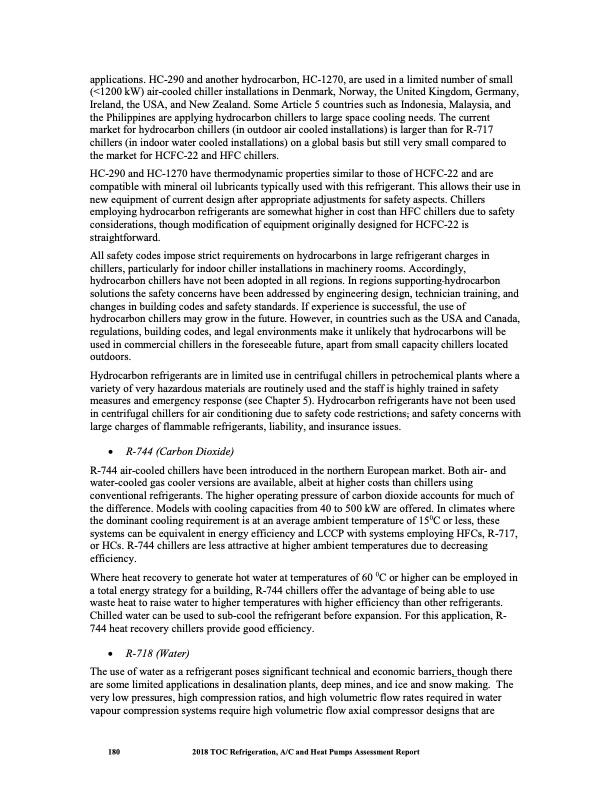
PDF Publication Title:
Text from PDF Page: 193
applications. HC-290 and another hydrocarbon, HC-1270, are used in a limited number of small (<1200 kW) air-cooled chiller installations in Denmark, Norway, the United Kingdom, Germany, Ireland, the USA, and New Zealand. Some Article 5 countries such as Indonesia, Malaysia, and the Philippines are applying hydrocarbon chillers to large space cooling needs. The current market for hydrocarbon chillers (in outdoor air cooled installations) is larger than for R-717 chillers (in indoor water cooled installations) on a global basis but still very small compared to the market for HCFC-22 and HFC chillers. HC-290 and HC-1270 have thermodynamic properties similar to those of HCFC-22 and are compatible with mineral oil lubricants typically used with this refrigerant. This allows their use in new equipment of current design after appropriate adjustments for safety aspects. Chillers employing hydrocarbon refrigerants are somewhat higher in cost than HFC chillers due to safety considerations, though modification of equipment originally designed for HCFC-22 is straightforward. All safety codes impose strict requirements on hydrocarbons in large refrigerant charges in chillers, particularly for indoor chiller installations in machinery rooms. Accordingly, hydrocarbon chillers have not been adopted in all regions. In regions supporting hydrocarbon solutions the safety concerns have been addressed by engineering design, technician training, and changes in building codes and safety standards. If experience is successful, the use of hydrocarbon chillers may grow in the future. However, in countries such as the USA and Canada, regulations, building codes, and legal environments make it unlikely that hydrocarbons will be used in commercial chillers in the foreseeable future, apart from small capacity chillers located outdoors. Hydrocarbon refrigerants are in limited use in centrifugal chillers in petrochemical plants where a variety of very hazardous materials are routinely used and the staff is highly trained in safety measures and emergency response (see Chapter 5). Hydrocarbon refrigerants have not been used in centrifugal chillers for air conditioning due to safety code restrictions, and safety concerns with large charges of flammable refrigerants, liability, and insurance issues. • R-744 (Carbon Dioxide) R-744 air-cooled chillers have been introduced in the northern European market. Both air- and water-cooled gas cooler versions are available, albeit at higher costs than chillers using conventional refrigerants. The higher operating pressure of carbon dioxide accounts for much of the difference. Models with cooling capacities from 40 to 500 kW are offered. In climates where the dominant cooling requirement is at an average ambient temperature of 150C or less, these systems can be equivalent in energy efficiency and LCCP with systems employing HFCs, R-717, or HCs. R-744 chillers are less attractive at higher ambient temperatures due to decreasing efficiency. Where heat recovery to generate hot water at temperatures of 60 0C or higher can be employed in a total energy strategy for a building, R-744 chillers offer the advantage of being able to use waste heat to raise water to higher temperatures with higher efficiency than other refrigerants. Chilled water can be used to sub-cool the refrigerant before expansion. For this application, R- 744 heat recovery chillers provide good efficiency. • R-718 (Water) The use of water as a refrigerant poses significant technical and economic barriers, though there are some limited applications in desalination plants, deep mines, and ice and snow making. The very low pressures, high compression ratios, and high volumetric flow rates required in water vapour compression systems require high volumetric flow axial compressor designs that are 180 2018 TOC Refrigeration, A/C and Heat Pumps Assessment ReportPDF Image | Heat Pumps Technical Options

PDF Search Title:
Heat Pumps Technical OptionsOriginal File Name Searched:
RTOC-assessment-report-2018_0.pdfDIY PDF Search: Google It | Yahoo | Bing
CO2 Organic Rankine Cycle Experimenter Platform The supercritical CO2 phase change system is both a heat pump and organic rankine cycle which can be used for those purposes and as a supercritical extractor for advanced subcritical and supercritical extraction technology. Uses include producing nanoparticles, precious metal CO2 extraction, lithium battery recycling, and other applications... More Info
Heat Pumps CO2 ORC Heat Pump System Platform More Info
| CONTACT TEL: 608-238-6001 Email: greg@infinityturbine.com | RSS | AMP |